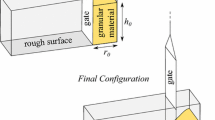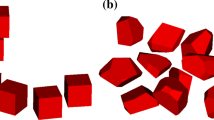Abstract
We investigate numerically the mechanism governing the quasi-static collapse of two-dimensional granular columns using a recently proposed continuum approach, the particle finite element method (PFEM), which inherits both the solid mathematical foundation of the traditional finite element method and the flexibility of particle methods in simulating ultra-large deformation problems. The typical collapse patterns of granular columns are reproduced in the PFEM simulation and the physical mechanism behind the collapse phenomenon is provided. The collapse processes obtained from the PFEM simulation are compared to experimental observations and discrete element modeling, where a satisfactory agreement is achieved. The effects of the macro density and friction angle of the granular matter, as well as the roughness of the wall surfaces on the quasi-static collapse, are also investigated in this paper. Furthermore, our simulations reveal new quasi-static collapse patterns, as supplements to the ones already observed in the experimental tests, due to the change of the roughness of the basal surface.














Similar content being viewed by others
References
Forterre, Y., Pouliquen, O.: Granular Media Between Fluid and Solid. Cambridge Press, Cambridge (2013)
Lube, G., Huppert, H.E., Sparks, R.S.J., Freundt, A.: Collapse of two-dimensional granular columns. Phys. Rev. E 72, 041301 (2005)
Lajeunesse, E., Monnier, J.B., Homsy, G.M.: Granular slumping on a horizontal surface. Phys. Fluids 17, 103302 (2005)
Mériaux, C.: Two dimensional fall of granular columns controlled by slow horizontal withdrawal of a retaining wall. Phys. Fluids 18, 093301 (2006)
Lube, G., Huppert, H.E., Sparks, R.S.J., Hallworth, M.A.: Axisymmetric collapse of granular columns. J. Fluid Mech. 508, 175–199 (2004)
Lajeunesse, E., Mangeney-Castelneau, A., Vilotte, J.P.: Spreading of a granular mass on a horizontal plane. Phys. Fluids 16, 2371–2381 (2004)
Balmforth, N.J., Kerswell, R.R.: Granular collapse in two dimensions. J. Fluid Mech. 538, 399–428 (2005)
Lube, G., Huppert, H.E., Sparks, R.S.J., Freundt, A.: Static and flowing regions in granular collapses down channels. Phys. Fluids 19(4), 043301 (2007)
Topin, V., Monerie, Y., Perales, F., Radjaï, F.: Collapse dynamics and runout of dense granular materials in a fluid. Phys. Rev. Lett. 109, 188001 (2012)
Rondon, L., Pouliquen, O., Aussillous, P.: Granular collapse in a fluid: role of the initial volume fraction. Phys. Fluids 23, 073301 (2011)
Maeno, F., Hogg, A.J., Sparks, R.S.J., Matson, G.P.: Unconfined slumping of a granular mass on a slope. Phys. Fluids 25(2), 023302 (2013)
Thompson, E.L., Huppert, H.E.: Granular column collapses: further experimental results. J. Fluid Mech. 575, 177–186 (2007)
Cundall, P.A., Strack, O.D.L.: A discrete numerical model for granular assemblies. Geotechnique 29(1), 47–65 (1979)
Staron, L., Hinch, E.J.: Study of the collapse of granular columns using two-dimensional discrete-grain simulation. J. Fluid Mech. 545, 1–27 (2005)
Zenit, R.: Computer simulations of the collapse of a granular column. Phys. Fluids 17, 031730 (2005)
Lacaze, L., Philips, J.C., Kerswell, R.R.: Planar collapse of a granular column: experiments and discrete element simulations. Phys. Fluids 20, 063302 (2008)
Huang, J., da Silva, M.V., Krabbenhoft, K.: Three-dimensional granular contact dynamics with rolling resistance. Comput. Geotech. 49, 289–298 (2013)
Kermani, E., Qiu, T., Li, T.: Simulation of collapse of granular columns using the discrete element method. Int. J. Geomech. 15(6), 04015004 (2015)
Staron, L., Hinch, E.J.: The spreading of a granular mass: role of grain properties and initial conditions. Granul. Matter 9, 205–217 (2007)
Lim, K.-W., Krabbenhoft, K., Andrade, J.E.: A contact dynamics approach to the granular element method. Comput. Methods Appl. Mech. Eng. 268, 557–573 (2014)
Zienkiewicz, O., Taylor, R., Zhu, J.: The Finite Element Method: Its Basis and Fundamentals, 2nd edn. Butterworth-Heinemann, London (2013)
Chen, W., Qiu, T., ASCE, M.: Numerical simulations for large deformation of granular materials using smoothed particle hydrodynamics method. Int. J. Geomech. 12(2), 127–135 (2012)
Holsapple, K.A.: Modeling granular material flows: the angle of repose, fluidization and the cliff collapse problem. Planet. Space Sci. 82–83, 11–26 (2013)
Mast, C., Arduino, P., Mackenzie-Helnwein, P., Miller, G.: Simulating granular column collapse using the material point method. Acta Geotech. 10(1), 101–116 (2015)
Cante, J.C., Oliver, X., Weyler, R., Cafiero, M., Davalos, C.: Particle finite element method applied to granular material flow. In: International Conference on Particle-Based Methods, Barcelona, Spain (2009)
Zhang, X., Krabbenhoft, K., Pedroso, D.M., Lyamin, A.V., Sheng, D., da Silva, M.V., Wang, D.: Particle finite element analysis of large deformation and granular flow problems. Comput. Geotech. 54, 133–142 (2013)
Cante, J., Davalos, C., Hernandez, J.A., Oliver, J., Jonsen, P., Gustafsson, G., Haggblad, H.A.: Pfem-based modeling of industrial granular flows. Comput. Part. Mech. 1(1), 47–70 (2014)
Zhang, X., Krabbenhoft, K., Sheng, D., Li, W.: Numerical simulation of a flow-like landslide using the particle finite element method. Comput. Mech. 55(1), 167–177 (2015)
Zhang, X., Krabbenhoft, K., Sheng, D.: Particle finite element analysis of the granular column collapse problem. Granul. Matter 16(4), 609–619 (2014)
Davalos, C., Cante, J., Hernandez, J., Oliver, J.: On the numerical modeling of granular material flows via the particle finite element method (PFEM). Int. J. Solids Struct. 71, 99–125 (2015)
Becker, P., Idelsohn, S.R., Oñate, E.: A unified monolithic approach for multi-fluid flows and fluid-structure interaction using the particle finite element method with fixed mesh. Comput. Mech. 55(6), 1091–1104 (2014)
Oñate, E., Franci, A., Carbonell, J.M.: A particle finite element method for analysis of industrial forming processes. Comput. Mech. 54(1), 85–107 (2014)
Salazar, F., Irazabal, J., Larese, A., Oñate, E.: Numerical modelling of landslide-generated waves with the particle finite element method (PFEM) and a non-newtonian flow model. Int. J. Numer. Anal. Methods Geomech. 40(6), 809–826 (2015)
Zhang, X., Sheng, D., Kouretzis, G.P., Krabbenhoft, K., Sloan, S.W.: Numerical investigation of the cylinder movement in granular matter. Phys. Rev. E 91, 022204 (2015)
Owen, P.J., Cleary, P.W., Meriaux, C.: Quasi-static fall of planar granular columns: comparison of 2D and 3D discrete element modelling with laboratory experiments. Geomech. Geoeng.: Int. J. 4, 55–77 (2009)
Nedderman, R.M.: Statics and Kinematic of Granular Materials. Cambridge Press, Cambridge (1992)
Alizadeh, F., Goldfarb, D.: Second-order cone programming. Math. Program. 95(1), 3–51 (2003)
Andersen, E.D., Roos, C., Terlaky, T.: On implementing a primal-dual interior-point method for conic quadratic optimization. Math. Program. 95, 249–277 (2003)
Wriggers, P.: Computational Contact Mechanics. Springer, Berlin (2006)
Zhang, X.: Particle Finite Element Method in Geomechanics. PhD thesis, School of Engineering, University of Newcastle, Australia (2014)
Chen, W., Qiu, T., ASCE, M.: Numerical simulations for large deformation of granular materials using smoothed particle hydrodynamics method. Int. J. Geomech. 12, 127–135 (2011)
Lemiale, V., Mhlhaus, H.B., Meriaux, C., Moresi, L., Hodkinson, L.: Rate effects in dense granular materials: linear stability analysis and the fall of granular columns. Int. J. Numer. Anal. Methods Geomech. 35(2), 293–308 (2011)
Krabbenhoft, K., Lyamin, A.V., Sloan, S.W.: Formulation and solution of some plasticity problems as conic programs. Int. J. Solids Struct. 44, 1533–1549 (2007)
Zhang, H., Li, J., Pan, S.: New second-order cone linear complementarity formulation and semi-smooth newton algorithm for finite element analysis of 3D frictional contact problem. Comput. Methods Appl. Mech. Eng. 200(14), 77–88 (2011)
Lotfian, Z., Sivaselvan, M.: A projected newton algorithm for the dual convex program of elastoplasticity. Int. J. Numer. Methods Eng. 97(12), 903–936 (2014)
Zhang, X., Sheng, D., Sloan, S.W., Krabbenhoft, K.: Second-order cone programming formulation for consolidation analysis of saturated porous media. Comput. Mech. (2016). doi:10.1007/s00466-016-1280-4
Krabbenhoft, K., Lyamin, A.V., Sloan, S.W., Wriggers, P.: An interior-point method for elastoplasticity. Int. J. Numer. Methods Eng. 69, 592–626 (2007)
Souloumiac, P., Krabbenhoft, K., Leroy, Y.M., Maillot, B.: Failure in accretionary wedges with the maximum stregth theorem: numerical algorithm and 2D validation. Comput. Geosci. 14(4), 793–811 (2010)
Mary, B., Maillot, B., Leroy, Y.: Deterministic chaos in frictional wedges revealed by convergence analysis. Int. J. Numer. Anal. Methods Geomech. 37(17), 3036–3051 (2013)
Stuart, A.M., Peplow, A.T.: The dynamics of the theta method. SIAM J. Sci. Stat. Comput. 12(6), 1351–1372 (1991)
Acknowledgments
The authors wish to acknowledge the support of the Australian Research Council Centre of Excellence for Geotechnical Science and Engineering and Australian Research Council’s Discovery Projects funding scheme (Project Number DP150104257). The work was performed in the Department of Civil Engineering at the University of Newcastle, Australia.
Author information
Authors and Affiliations
Corresponding author
Appendix
Appendix
1.1 Time discretisation
The momentum conservation equations (1) can be discretised using \(\theta \)-method [50] as:
where \({\varvec{v}}\) are velocities, subscripts n and \(n+1\) refer to the known and new, unknown states, and \(\varDelta t=t_{n+1}-t_n\) is the time step. Rearranging the above equations leads to
where \(\varDelta {\varvec{u}} = {\varvec{u}}_{n+1}-{\varvec{u}}_n\) and
The natural boundary conditions (6) are approximated in an analogous manner leading to
where
Following [26], the above problem can be stated in terms of a min-max problem:
on the basis of the Hellinger-Reissner variational principle. In above, \({\varvec{r}}_{n+1}\) are a set of variables interpreted as dynamic forces [26], and the notation
is utilised. The equivalence between the optimisation problem (18) and the governing equations at hand is established by demonstrating that the Euler-Lagrange equations associated with (18) indeed reproduce the governing equations [26].
1.2 Spatial discretisation
Using the standard finite element notation, the following approximations
are introduced for the state variables, where \(\hat{\varvec{\sigma }}\), \(\hat{\varvec{r}}\) and \(\hat{\varvec{u}}\) are the nodal variables, \(\varvec{N}\) matrices contain the shape functions, and \(\varvec{B}_u = \varvec{\nabla } \varvec{N}_u\). Substituting the above approximations into the variational principle (18) results in the following discrete principle:
where \(n_\sigma \) is the number of Gauss integration points, and
Then, solving the minimisation part of (24) gives a maximisation problem as:
At this stage, the contact constrains (4) are imposed on all potential contact nodes (i.e. mesh nodes located on the boundaries), which leads to a final problem of the type:
where \(\varvec{\rho } = (\rho _1,\rho _2)^\textsf {{\tiny T}}\) are the nodal forces, \(\varvec{n}=(n_1,n_2)^\textsf {{\tiny T}}\) and \(\hat{\varvec{n}} = (-n_2,n_1)^\textsf {{\tiny T}}\) are the normal and the tangential of the rigid boundary, \(\varvec{E}\) is an index matrix of zeros and ones, and \(n_c\) is the number of potential contacts.
The above problem can be transformed into a standard form of the second-order cone program (SOCP) and then solved using the high performance optimization solver MOSEK [38]. The transformation of (30) into SOCP standard form is straightforward and has been documented in [40]. In the course of solving the problem, the kinematic variables (displacement increments and plastic multipliers) are recovered as the dual variables, or Lagrange multipliers, associated with the discrete equilibrium constraints.
Rights and permissions
About this article
Cite this article
Zhang, X., Ding, Y., Sheng, D. et al. Quasi-static collapse of two-dimensional granular columns: insight from continuum modelling. Granular Matter 18, 41 (2016). https://doi.org/10.1007/s10035-016-0643-z
Received:
Published:
DOI: https://doi.org/10.1007/s10035-016-0643-z




